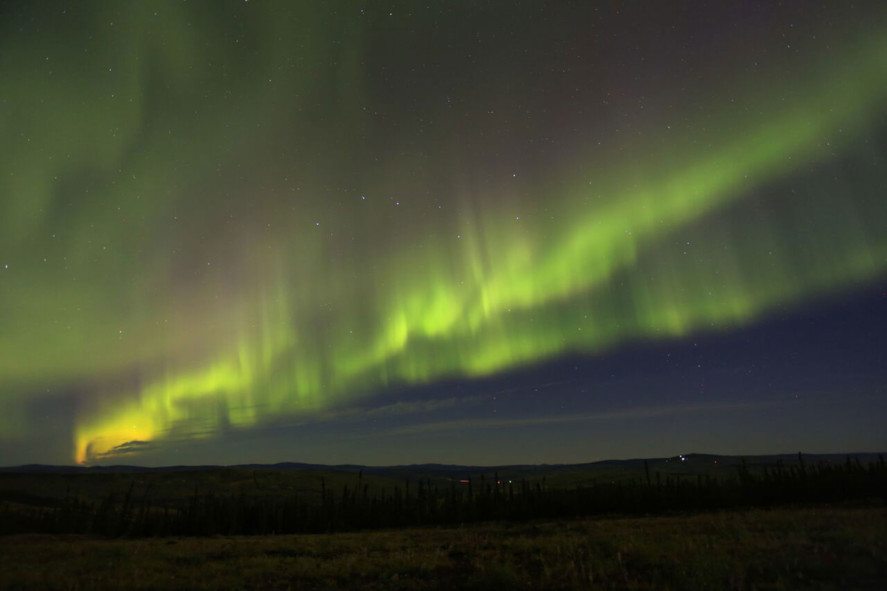The first time you see the Northern Lights (officially known as “aurora borealis”), they will simply take your breath away. An evolving natural light show with changing shapes and colors with mesmerizing effects.

Here are 10 fascinating facts and trivia about the Northern Lights and Aurora Borealis:
#1: “Northern Lights” is a pretty-much perfect name for Alaska’s thrilling, sky-filling sensations. But where does the name Aurora Borealis come from? Investigate its origins and you’ll find that name is also fitting and fascinating. In the 1600s, legendary astronomer Galileo was rumored to be the first to label the lights Aurora Borealis: Aurora, derived from Latin, is the name of the Romans’ Goddess of the Dawn; and Boreas is the God of the North Wind.
#2: References and legends about Aurora Borealis date back far into history, from Babylonian artifacts noting light sightings in the sky around 600 B.C. to astonished Greeks trying to explain them to others in 400 B.C., to indigenous peoples of the Arctic, some who thought wildlife traveled under the lights. Scandinavians believed their fabled Ullr, the Norse God of Winter, created the lights on the darkest and coldest northern nights. Benjamin Franklin even penned the paper “Aurora Borealis, Suppositions and Conjectures towards forming a Hypothesis for its Explanation.”
#3: Same phenomenon, different names. In the Northern Hemisphere, from Alaska to the Arctic, the lights are known as Northern Lights or Aurora Borealis. But these dancing lights also light up certain lower regions of the Southern Hemisphere (Antarctica, Australia, New Zealand, Argentina, Chile) and are known as “Aurora Australis” and, you guessed it, Southern Lights.
#4: What creates the vibrant colors of the Northern Lights? Northern lights colors are all about the air up there. When solar storms simmer and stir, the lights created by oxygen omissions are most often seen in green due to the accelerated atomic activity that takes place 60-200 miles above Earth. Oxygen at altitudes above that will often glow red; nitrogen below the 60-mile mark will often appear as purple or blue.

Northern Lights in sky above moonlight on the Chugach Mountains along the Turnagain Arm
#5: Who knew that the Northern Lights can actually be heard? While northern lights displays create excitement for eyes and inspire oohs and aahs of amazement, they occasionally create their own aural awesomeness. Seriously. Stand quietly and still under a low light display on a cold winter night and you might just hear the lights crackling, snapping, hissing, and popping like static. That’s what happens when the sun’s super-hot solar particles crash into the frigid and moist air above Alaska. It’s a rare and special occurrence that you’ll never forget.
#6: A Natural Wonder of the World. The Northern Lights are listed among the Seven Natural Wonders of the World, along with the Grand Canyon, the Great Barrier Reef, Mount Everest, Rio de Janeiro, Victoria Falls and Niagra Falls.
#7: The Aurora: A celestial event for all. Earth isn’t the only planet lucky enough to have these legendary lights. Jupiter and Saturn each contain plenty of gas and also have the classic combination of major magnetic fields, wide-ranging radiation belts, and serious solar activity and to produce unique auroras. While these lights sparkle above planets far, far away, Earthlings have viewed them thanks to the work of the Hubble Space Telescope and other spacecraft. While not as powerful or impressive, Uranus, Neptune, Venus, and Mars also have their own various auroras.

Fairbanks Aurora Viewing- credit to Hung Chia Hwei.
#8: Spectacular and unforgettable Northern Lights events include the Great Geomagnetic Storm of 1859, a solar storm the likes of which had never been witnessed before. From August 28-Sept. 2, 1859, surging sunspot activity literally lit the skies with bright and brilliant color around the world, even at locales closer to the equator than the magnetic poles like Chile, Mexico, the Caribbean, Cuba, Hawaii, Japan, and China. The super-storm made headlines around the world, thrilled physicists, astronomers, and mathematicians, and shocked many common Earthlings. The solar coronal mass ejection that blasted into the Earth’s magnetosphere on Sept. 2 went down as the biggest recorded storm ever. The surges were so intense, there were reports of telegraph systems crashing and even shocking their operators. Many believe that if a similar solar storm were to hit Earth today, our high-tech devices and infrastructure would be fried, communication with most satellites would cease, and electrical grids would shut down.
#9: Where to get the best views of the Northern Lights…Aurora viewing in Alaska is pretty amazing, but the astronauts and residents of the International Space Station may have the best perspective. They are often orbiting around the same altitude, over 200 miles above the Earth, or higher than a significant array of aurora activity. NASA and station residents have produced numerous mind-blowing photos and videos of solar storms and their resulting bright and colorful lights. Some have even written about the otherworldly experience of “flying through an aurora.”
#10: Just a nightly event or a daily one? Northern lights aren’t just a winter phenomenon or a nighttime occurrence. Aurora is active, to some extent, all day, every day. They are just really difficult, if not impossible, to see when there’s daylight, which is why they are best known for being spotted at night during Alaska’s dark winter months.
Do you have viewing the Northern Lights and Aurora Borealis on your Alaska bucket list? Visit us this winter on one of our popular Northern Lights tours and discover the magic of this unique natural phenomenon, all for yourself
